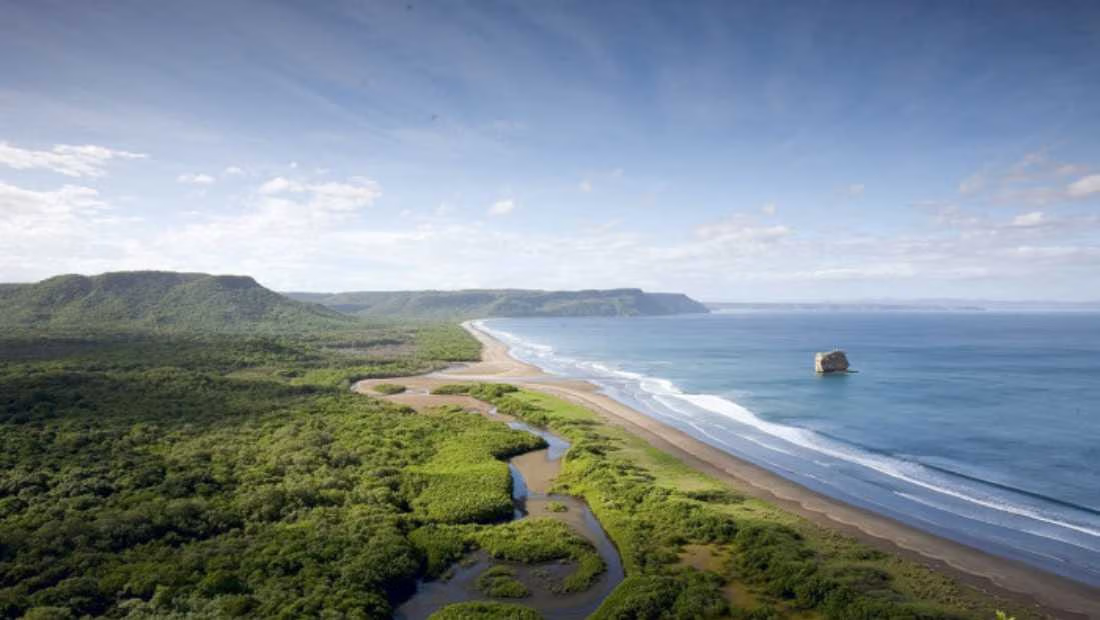
Santa Rosa National Park
BY NAMUBAKShare
The Santa Rosa National Park , located in Guanacaste, Costa Rica, is a treasure of history and nature, declared a World Heritage Site. This park is not only famous for its landscapes and biodiversity, but also for its historical significance, as it was the site of the historic battle of March 20, 1856.

Santa's Mansion Rosa: History and Culture
He Santa Rosa National Park It is the only Protected Wild Area in Costa Rica that houses a historical museum within its territory. This museum, known as The Casona de Santa Rosa commemorates the historic Battle of Santa Rosa, a crucial event in the 1956 Campaign. According to Juan Carlos Carrillo, tourism coordinator for the Guanacaste Conservation Area, “it was the most important historical point of the heroic deed in the 1956 Campaign, where in just 15 minutes one of the most important pages for the country was written.”
The park offers a detailed timeline of the national campaign, complemented by photographs and documents, providing an educational and cultural experience for visitors. This information was painstakingly compiled by specialists, with the support of museum institutions such as the Juan Santamaría Historical Museum.

Flora and Fauna of Santa Rosa National Park
He Santa Rosa National Park It preserves the only patch of dry tropical forest in Mesoamerica, one of the most threatened and unique ecosystems on the planet. This forest connects with humid, cloud, and rainforests, creating impressive biological diversity. The park also contains Some of the oldest lands in Costa Rica are found here, having emerged from the sea more than 85 million years ago.

Flora of Santa Rosa National Park
The park's flora is rich and varied, highlighting species adapted to the conditions of the tropical dry forest. Some of the most notable species include:
- Ateleia herbert-smithii : The world's only natural population of this wind-pollinated legume.
- Guanacaste Trees : Emblematic of the region, providing shade and support to local fauna.
Fauna of Santa Rosa National Park
The park's fauna is equally diverse, with species ranging from large mammals to birds and reptiles. Some of the species that inhabit the park include:
- White-tailed deer
- Howler monkeys and white-faced monkeys
- Loras Turtles : Which spawn on Nancite Beach
Sectors of the Santa Rosa National Park
He Santa Rosa National Park It is divided into two main sectors: Murciélago and Santa Rosa itself.
Santa Rosa Sector
He Santa Rosa Sector It is known for having the largest sample of dry tropical forest in Central America. This area is also home to two beaches: Naranjo Beach and Nancite Beach . At Playa Naranjo, visitors can camp and enjoy activities such as surfing, especially at the famous surfing spot. Witch's Rock , known for its spectacular waves. Nancite Beach is a biological site where lora turtles nest.

Bat Sector
He Murciélago Sector , located in the northern part of the Santa Elena Peninsula, is famous for its beaches such as El Hachal, Danta, Coquito, Santa Elena and Blanca. This area offers parking, picnic tables, restrooms, drinking water, and a camping area.
It also has viewpoints and trails, allowing visitors to enjoy the dry forest and beaches.
Marine Sector
He Marine Sector The park encompasses 43 Marine Protected Areas, rich in reef biodiversity and a variety of fish. This sector is ideal for recreational activities like walks in boat, diving and snorkeling.
Activities in Santa Rosa National Park
He Santa Rosa National Park offers a wide variety of activities for its visitors, including:
- Hiking : With several trails available ranging from easy to moderately difficult.
- Camping : With designated camping areas at Playa Naranjo.
- Surfing : Especially at Playa Naranjo, known as Peña Bruja.
- Cultural visits : To the La Casona Historical Museum and the Monument to the Heroes.
- Wildlife Observation : Taking advantage of the park's rich biodiversity.

Services and Facilities
The park offers a variety of services for the convenience of visitors, including:
- Drinking water
- Viewpoints
- Camp area
- Lunch area
- Health services
- Parking lot
- Rooms in hostel
Rates and Schedules
To visit the park, the following fees apply:
- Nationals :
- Adults: ¢1243
- Children (2-12 years): ¢565
- Students: ¢565 (Primary and Secondary in organized groups)
- Foreigners :
- Adults: $16.95
- Children (2-12 years): $5.65
Camper rates per person per day:
- Nationals : $4 + Entrance Fee
- Foreigners : $4 + Entrance Fee
Visitor hours are Wednesday through Monday, 8:00 a.m. to 3:30 p.m. (reservations required). The La Casona de Santa Rosa Historical Museum is also open Wednesday through Monday, 8:00 a.m. to 3:30 p.m.
Recommendations for Visitors
To fully enjoy the park and its respective sectors, it is recommended:
- Wear closed shoes, a long-sleeved shirt, and a hat.
- Bring insect repellent and sunscreen.
- Bring enough water and light food.
- Respect the park's rules and regulations to preserve its natural and cultural beauty.
How to Get to Santa Rosa National Park
Access to the Santa Rosa National Park It's simple. From San José, take the Inter-American Highway toward Liberia and continue for approximately 35 km to the main park entrance. From there, travel an additional 7 km to reach the La Casona Historical Museum, where you'll find the registration and information office. The Playa Naranjo site is 12 km from the La Casona Museum, while the Murciélago Sector is 45 km from Liberia. Continue 10 km to the Cuajiniquil Community and then a gravel road for another 9 km to the sector entrance.
The Santa Rosa National Park It's a must-see destination for those interested in history, nature, and adventure. With its rich biodiversity, historical significance, and diverse activities, this park offers a unique experience for all visitors. Don't miss the opportunity to explore one of Costa Rica's most iconic parks and immerse yourself in the beauty and history of the park. Santa Rosa .

